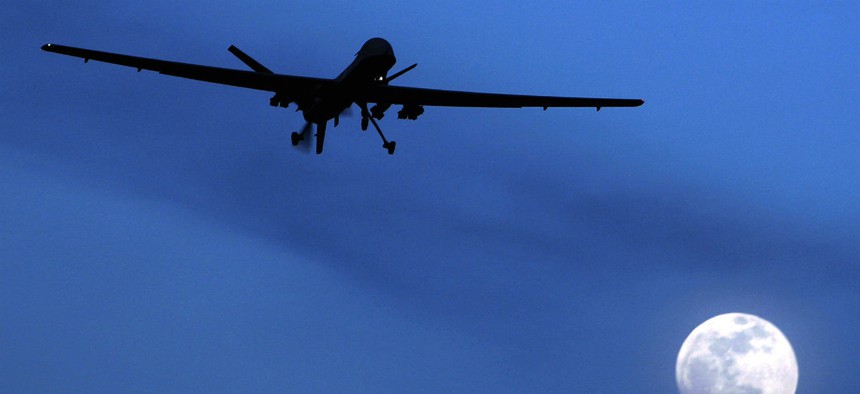Drones Armed With High-Energy Lasers May Arrive In 2017

Kirsty Wigglesworth/AP File Photo
Predator maker looks beyond Hellfire missiles to the weapons of the future.
Flying military robots armed with high-energy lasers? It’s a future that is exciting, terrifying — and perhaps just two years away.
General Atomics Aeronautical Systems, Inc., or GA-ASI, the San Diego-based company that makes the Predator and Reaper drones, is undertaking a privately funded study to integrate a 150-kilowatt solid-state laser onto its Avenger (née Predator-C) drone. If the company succeeds, a drone with a high-energy laser will be a reality at some point in 2017, company executives told Defense One.
“We’re funded right now to develop a laser module compatible with the aircraft and study putting it on the Avenger,” Michael Perry, Vice President for Mission Systems at GA-ASI, told Defense One. “We hope to be funded to do that,” he said.
The company is far better known for its MQ-1s and MQ-9s — the backbones of the Pentagon’s drone strike force — than for its work with lasers. But in June, the company delivered a 150-kilowatt liquid laser to the Pentagon for extensive testing at the White Sands Missile Range in New Mexico.
For comparison, the 30 kw laser (output) currently on the Ponce in the Persian Gulf has more than enough output to destroy an enemy drone or blow a hole in a boat. In addition to 5 times the power, the significant increase in beam quality provides significantly higher lethality than the system on the Ponce.
Bringing these two technologies together involves a lot more than strapping a laser cannon under the drone’s wings. Hitting a target with a laser mounted on a vibrating platform moving quickly through air laden with dust and water vapor is tougher than launching a Hellfire at a moving vehicle.
“Before you spend any money on a laser you better darn well show that you can acquire, ID, and track the objects of interest so that you could put a laser on them,” said Perry. “You have to be able to compensate for aero-optic distortion.”
After you solve the targeting problem, the laws of physics present their own challenges. Lasers in the 150-kilowatt range are big, heavy, and power-hungry. Shrinking size-weight-and-power, or SWAP, scores to workable levels remains the biggest obstacle to arming aircraft with lasers. Weight alone will likely bar 150 kw lasers from the MQ-1; engineers have set their sights on building weapons for the Predator-C and its 3,000-pound payload capacity.
GA-ASI has designed a power system for drone lasers that works almost like a hybrid car, the non-plugin kind. “You use the aircraft power to charge an intermediate storage system, and then that runs the laser when it’s doing laser shots,” said Perry.
He said the current design can get off five or six shots before needing to recharge, which happens in the air, over the course of several minutes.
“If there’s enough time between shots you never have to recharge at all. It depends on how much time you have to re-target,” said Perry.
While GA-ASI is underwriting the current research, the military is keen get lasers onto aircraft. The Missile Defense Agency, orMDA, has funded research on tracking and targeting capabilities for drones.
“The work that we’re doing with the General Atomics Reaper and the work that we did with the Boeing Phantom Eye starts to show it can be done, in terms of these long-range sensing and tracking capabilities that we need,” MDA director Vice Adm. James Syring told reporters last month.
“We’ve been funded for years to develop high-energy laser systems. The maturity of our approach is further along than others because we’ve been working on it for a long time, for 15 years. [high-energy laser research is] coming out of the laboratory in a leakage-type way” GA-ASI’s Perry said.
The company has another advantage over its competitors in the race to build laser-armed drones: they make the ground control stations, including the next generation ground control station that the Pentagon hopes will improve the dreary job of drone operation. This gives them an advantage when it comes to creating the virtual gunsights and trigger for the laser.
“What we’ve shown is that the laser control is compatible with the new ground station,” he said. ”From a hardware standpoint, all the hardware exists to control it inside the station.”
However, Perry says that laser drones will require an entirely new software load, and that’s not all: “You’ll have a whole new concept of operations. Completely new training will be required,” he said.
If GA-ASI — or someone else — succeeds in making lasers into a practical wing-mounted weapon, it will usher in a new battlefield role for medium-sized tactical drones. Perry imagines a completely different mission than simple loitering and striking targets, one more geared toward protecting U.S. forces from enemies that are firing on them.
“You would have a capability for close-air support, aircraft defense, counter-air, and even some types of non-lethal actions. You would really be expanding the mission space… The focus at this point is principally defensive missions,” he said.






